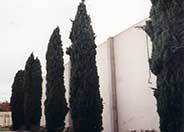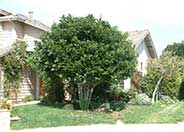
Common name:Italian Cypress
Botanical name:Cupressus sempervirens 'Stricta'
Italian Cypress is often associated with Italian and Spanish architecture, providing columns in the landscape. They often reach 60' tall. 'Stricta' is compact, columnar and produces long, straight branches with deep green foliage.

Common name:Carrotwood, Cupania
Botanical name:Cupaniopsis anacardioides
This evergreen tree will grow up to 40' high and has leathery, dark green leaves. When the trees approach maturity, yellow to orange fruit may be produced; it does well in wet soil.

Common name:Brisbane Box
Botanical name:Lophostemon confertus
Brisbane Box (Tristania conferta) is a very fast-growing evergreen tree that is native to Australia. It is a common tree to use in parkways and residential gardens because it is low-water-use, low maintenance, and resistant to pests, disease, and smog conditions. This is a great selection to be used in a medium garden to screen neighboring houses or undesirable views, as the tree is fast-growing and has a dense, upright canopy, maturing at 50’ tall and up to 30’ wide. This tree can take most soil and water conditions, so it can be used in almost all styles of gardens. It is very drought-tolerant, but its larger, dark green leaves make it look lush. When it starts to reach its mature height, the tree can thin out, giving it a more arid look. If the desired effect in the garden is to have a full, dense canopy, it is best to leave the pruning and care to a licensed arborist. There is no need to fertilize this tree as it already has a fast-growth habit, and the supplemental nutrients will only encourage more growth. This tree should be planted at least three feet away from any hardscape areas, eight feet from structures such as houses and buildings, and not near any powerlines. Shrubs and perennials should be planted about two feet away from this tree. It should be irrigated for about 45 minutes once a week when using most in-line drip irrigation systems.
Designer: N/A
Photographer: GardenSoft
Incorporate compost 6" into your soil to retain water, reduce compaction, feed earthworms, and provide valuable nutrients to your plants.
Mulching and adding compost to soil can minimize evaporation and help soil absorb and store water.
Remove irrigation water and fertilizer from areas where you don't want weeds to grow.